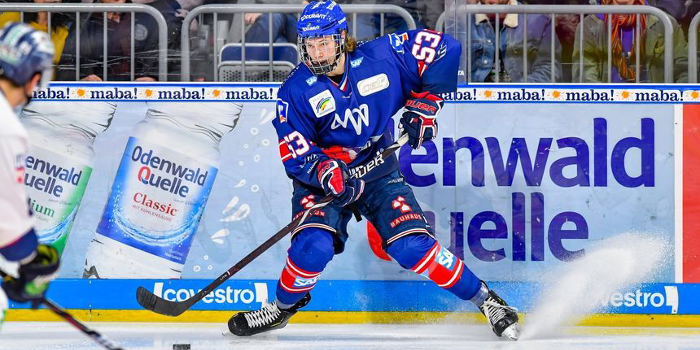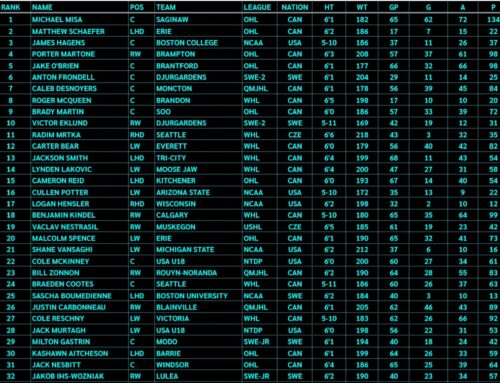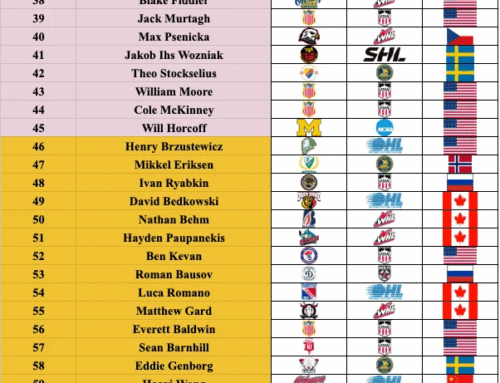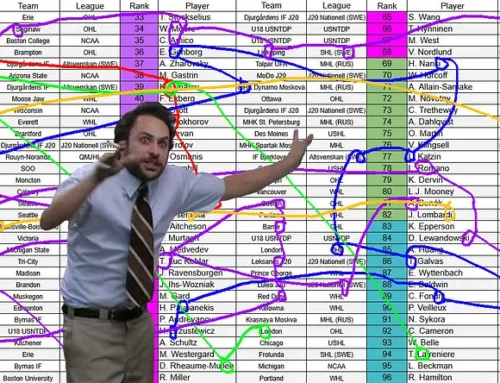Prospect Deep Dive: Moritz Seider
Tony Ferrari
2019-05-29

Being a high-end draft prospect coming from the German top league DEL is rare. Being an elite blue-line prospect coming from that league is even less likely. Moritz Seider is an intriguing player because of his tools and the lack of a prior precedent in his situation. The right-shot player is a solid two-way defender who is developing high-end skills on both ends of the ice.
Hockey Card Stats
Name: Moritz Seider
Club Team: Adler Mannheim (DEL)
Position: D
D.O.B: April 6th, 2001
Place of Birth: Zell, Germany
Height: 6’4”
Weight: 198lbs
Shoots: R
Ranked #21 by TSN/McKenzie
Ranked #11 by HockeyProspect.com
Ranked #17 by Future Considerations
Ranked #26 by McKeen’s Hockey
Ranked #17 by EliteProspects.com
Ranked #27 by ISS Hockey
Ranked #6 by NHL Central Scouting (EU Skaters)
Scouting Report
Skating and Transition
Seider is an excellent skater in both directions. His top speed is good-to-great and first step quickness is quite good but not elite. He is able to keep up with plays in all three zones of the ice, effortlessly skating through the middle of the ice. His edge work is good and he changes directions in an instant which is a big strength, whether it’s moving laterally to either side of transitioning from offense to defense. Seider has good awareness of the situations he’s put in, using his mature hockey IQ to put himself a step ahead of the opposition more times than not. The young German excels at skating with the puck on his stick, often looking poised beyond his years while playing with men. Despite a tendency to be caught puck watching a bit while the puck is deep in the offensive zone, Seider is able to use his skating ability to work his way back into a play when he is beat on a pinch. In the video below, Seider shows off his excellent skating and soft touch with the puck when he joins the rush in the World Hockey Championship recently.
{youtube}2w6Fp6tOLwQ{/youtube}
Using his long frame, Seider has a long stride that will likely become more powerful as he grows and physically matures into his early-to-mid-20s. The lack of explosive power in his first few strides is the biggest detractor in his skating. The great top speed often helps him keep up in puck races. The two-way blue-liner uses his excellent change-of-direction ability to make up for any short burst situations, often times getting a jump on a forward in the loose puck battles because he transitions laterally more quickly.
Offensive Zone
Coming into the year, Seider was expected to showcase his offensive game as a player who has produced well at junior levels throughout his early career. To the surprise of many, he was asked to play a much more defensive game and succeeded in that role for Adler Mannheim in the DEL. As a 17-year-old playing in a men’s league, he showed flashes of offensive talent throughout the year. He produced at a modest rate, six points in 29 games. The problem with projecting his offensive production using just his statistics is that prospects coming out of the German league are extremely rare. The closest comparison we have is Christian Ehrhoff prior to the 2001 draft. In his draft season, Ehrhoff put up 14 points in 58 games in the DEL. In per-game rates, that puts Seider just behind Ehrhoff at 0.20 and 0.24 points-per-game respectively.
Seider’s passing ability is among the best in the draft class on the back-end. He has the ability to complete crisp passes from high in the zone to all areas of the offensive zone. His saucer passes are controlled and accurate on the tape of his teammates’ sticks. He skates the blue-line well, effectively changing angles to get shots through traffic. His wrist shot is hard and accurate from the point. Maybe his most effective shot at creating chances, Seider’s wrist shot is an NHL ready weapon from the back-end as he puts it in the spots he wants it. He doesn’t always shoot to score, rather he puts an accurate shot on net to create a rebound for the forwards crashing the net.
Seider also possesses a heavy slap shot that he utilizes very well on the power play. While not a typical power play quarterback, the young Deutschland defender does an excellent job keeping the puck moving and distributing the puck to the open player. He opens himself up to take the one-timer and pinches lower into the offensive zone to the top of the circle and shifts into the high slot when he needs to find some space. Very fluid in the offensive zone, he may not be a true offensive defenseman, but he does an effective job on the offensive end of the ice, creating space for himself and teammates while finding the vacant areas to open himself up for a shot.
Defensive Zone
Asked to play a much tighter game moving up to the top men’s league in Germany, Seider stepped up to the plate and improved throughout the year. Often playing top-four in the DEL, he was able to make defensive plays with both his body and his stick. Seider did an adequate job against bigger, stronger men not looking out of place physically. While he wasn’t consistent in it, he often didn’t shy away from stepping up on an oncoming forward. This sometimes put out Seider out of position but his skating often covered the mistake when he had the appropriate coverage behind him.
His positioning in the defensive end of the ice was generally good. He uses his large frame to clog passing lanes and get in the way of open looks at the net. He does a good job at working for position at the net front, ensuring the goalie isn’t screened but he has had trouble at times with stronger men. The hope is that with his body maturing physically he will continue to gain strength, negating the advantage that more developed men have had at times in the DEL.
#WC: More Moritz Seider — Freddy Tiffels makes a bad pass that is picked off by Dylan Larkin. Seider identifies it and takes the best route towards Larkin, but also communicates with his partner that he’s taking the puck. He then collects it at center and dumps in for a change. pic.twitter.com/iZUlf4TrDF
— Steve Kournianos (@TheDraftAnalyst) May 7, 2019
Defending the rush is inconsistent at times but there was improvement throughout the year. Initially, in the DEL, Seider was playing a bit timid and at times would allow oncoming forwards on the rush to back him off the blue-line. As the season progressed, specifically after the World Junior D1A Championship, his confidence seemed to grow and his aggressiveness at both ends began to show. Specifically, on the defensive end, Seider began to keep closer gaps. Closing in and poking the puck away with his stick while he rubbed the player out on along the boards, using his body to effectively close on the rush without taking himself out of the play. His defensive game developed into a strength over his Rookie of the Year season in the DEL.
Year in Review
DEL
Playing in the DEL as a 17-year-old is an accomplishment in and of itself, but the young rearguard was excellent in his time with Adler Mannheim, winning the aforementioned Rookie of the Year. Not without his struggles, Seider was asked to play a more solid game in his own end as he was playing in a men’s league where he could be victimized by more mature and physically imposing opponents. The focus on the defensive end led to decreased contributions offensively. Coming into the season known more for his offensive skill than his defensive prowess, he altered his game to help the team by playing a defensive style against players that were often five to ten years his senior. His development as a two-way defenseman was steady to start the season.
His rise in many rankings came after the World Junior U20 Division 1A Championship (see below). Upon his return to Adler Mannheim, he began to exude confidence. His play at both ends of the ice began to seem more mature and pro-ready. His comfort level had clearly settled and he began to show the same sort of puck movement and defensive efficiency that he showed at the junior tournament. He played steady minutes on the Mannheim blue-line, impacting the game in all three zones as an efficient and effective player. Offensively, he began to push the pace of play more consistently. He didn’t shy away from shooting the puck or making a move on the point to open up a passing or shooting lane. Transitionally, he began to test opponents with passes that stretched the neutral zone and he carried the puck as he transitioned through the middle of the ice. His play in his own end was the biggest improvement. Seider played with increased intensity, engaging more physically and winning battles in front of the net and in the corners with a higher rate of success.
Heading into the DEL playoffs with Mannheim, Seider’s coach, Pavel Gross, continued to trust the youngster. After playing him over 14 minutes in the quarter-finals, Seider earned top-pair billing for the semi-finals. The trust that was shown to Seider was absolutely earned. Seider displayed mature play throughout the season, never getting too high when he experienced success and never getting too low after disappointment, Seider proved that at the tender age of 17 (turning 18 late in the season), he was a man ready to compete against fellow men. In the video below, Seider does an excellent job at identifying an opening to join the rush and accepts a pass in his feet, maintaining control of the puck. After gaining full possession, he used his skating to create dove and hit the crossbar with his shot. This came in the deciding game of the DEL Championship. Seider helped lead his DEL squad to the league title. His play for the DEL champions was impressive to say the least.
This was #2019NHLDraft eligible RHD Moritz Seider in the DEL final. He does an excellent job identifying the opening and space along the right side of the ice and jumping into the rush. Doesn’t convert but rings it off the cross-bar. pic.twitter.com/l8lnMgO9Ol
— Tony Ferrari (@theTonyFerrari) May 28, 2019
Despite facing two somewhat lengthy absences due to issues with his shoulder, Seider returned and showed improved development throughout the season. The emergence of his solid play in his end as well as the ability to skate with the puck and make an impact on the offensive end make Seider one of the most complete defensemen in the draft behind Bowen Byram.
WJC-U20 D1A
Seider’s choice to spend the season in the top German league was interesting. Not many prospects come from the DEL as they generally move to a higher tier league in Europe or they move to North America for their draft-eligible year. As we don’t have many precedents, we have to work with the limited sample size in terms of comparable players for projection as well as examine his play among his peers at international tournaments both at the junior and men’s levels.
This leads to his exceptional play at the WJC-D1A U20s this year. Seider captained the German team to the gold medal which gives them a birth in the top level tournament next year. The 17-year-old captain had a goal and seven points in just five games of a tournament that is generally dominated by 19-year-olds. He was a one-man wrecking machine, dominating at both ends of the ice. Defensively responsible and engaged, Seider did an excellent job at showing off his development from playing in the German men’s league. Offensively, he pushed the German team up the ice, generating chances and being a catalyst for the German team. His exceptional performance in his age-17 season means that he is likely to get at least once more chance to play for the German team next season at the top-tier World Junior Championship.
World Hockey Championship
Seider was one of three prospects from near the top of the 2019 NHL Entry Draft to make their respective World Championship team, the others being American Jack Hughes and Finnish winger Kaapo Kakko, the top two ranked prospects across prospect rankings. While Seider didn’t come with as much hype as the likely top two picks of the draft, Seider had a fairly strong tournament for a strong German team. An unfortunate concussion leads to his tournaments premature ending.
{youtube}gRsWSZrcAq8{/youtube}
Scoring two goals in five games before injury struck, Seider was one of Germany’s top defenders. He took a regular role on the power play and did an excellent job at 5-on-5. As you can see in the video above, Seider is patient on the power play. He doesn’t force a shot on his initial chance, returning the puck to the second high man and allowing for the lateral puck movement to force the goalie to move east-west before firing a return pass into the pack of the net.
Late in the Germans’ fifth game of the tournament against Slovakia, Seider was hit by former NHLer Ladislav Nagy. Seider hit the boards hard, slamming his head on the glass. This was followed by Seider down on the ice, slow to his feet. He was eventually helped off and didn’t play another game in the event. An unfortunate end to a promising tournament. The positive showing by the draft-eligible prospect created another burst of hype leading up to the draft at the end of June.
Conclusions
Moritz Seider is an intriguing prospect. He’s shown extremely well at international tournaments, both at the national and junior tournaments, and more than held his own in a lower-level men’s league in the DEL. He dealt with injury issues at times but returned stronger each time. His combination of a developing defensive game, hockey IQ and an offensive skill-set that’s maturing help make him one of the best and most well-rounded defenders in the 2019 NHL Draft.
I don’t think it’s a consensus. To be honest, the two Swedes, York, Harley, Heinola, and Seider are all right in the mix to be the 2nd D off the board. https://t.co/CcyOOU7wbX
— /Cam Robinson/ (@Hockey_Robinson) May 24, 2019
With no consensus number two defender in the draft, Seider has a shot at being the second defenseman off the board. He has arguably the best two-way game outside of Byram in the draft. He plays a complete game that could be NHL ready in two years or less. His contract in the DEL runs through 2020-21 so there is a possibility that Seider won’t be in North America right away. If he does make the jump to this side of the ocean, he could immediately step into an AHL lineup for the purpose of being within the organization of whichever team drafts the young German. The possibilities for where Seider plays next season remain fluid, likely being determined by whichever team takes a chance on the young defender from Deutschland.
Thank you for taking the deep dive on one of the most interesting players in this upcoming draft, Moritz Seider. Come back soon for more draft prospect deep dives from the DobberProspects team! Leave comments below and you can always reach out to me personally on twitter at @TheTonyFerrari!
Previously on Prospect Deep Dive:
Main picture courtesy of morgenweb.de






